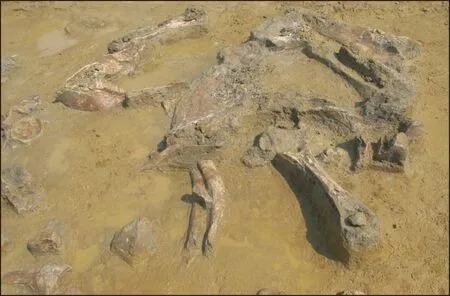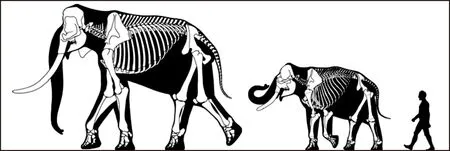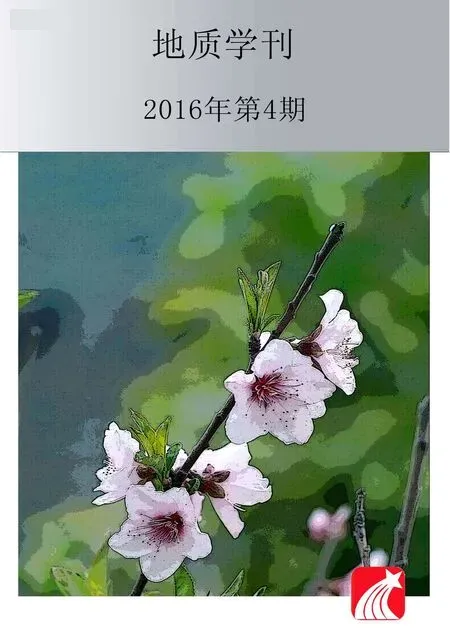The Discovery of A Late Pleistocene Palaeoloxodon huaihoensis from Sihong County, northern Jiangsu Province, China
QIAN Maiping, ZOU Songmei, LI Shuang, JIANG Ren, SUN Ailian, ZU Yikang, SHI Fei, YU Junjie, PENG Bo, ZENG Jianwei
(1. Nanjing Geological Survey Center of China Geological Survey, Nanjing 210016, Jiangsu, China; 2. Geological Survey of Jiangsu Province, Nanjing 210018, Jiangsu, China; 3. Sihong Bureau of Land and Resources, Sihong 223700, Jiangsu, China; 4. Land and Resources of Jiangsu Province, Nanjing 210017, Jiangsu, China)
The Discovery of A Late Pleistocene Palaeoloxodon huaihoensis from Sihong County, northern Jiangsu Province, China
QIAN Maiping1, ZOU Songmei2, LI Shuang3, JIANG Ren1, SUN Ailian4, ZU Yikang3, SHI Fei3, YU Junjie1, PENG Bo1, ZENG Jianwei1
(1. Nanjing Geological Survey Center of China Geological Survey, Nanjing 210016, Jiangsu, China; 2. Geological Survey of Jiangsu Province, Nanjing 210018, Jiangsu, China; 3. Sihong Bureau of Land and Resources, Sihong 223700, Jiangsu, China; 4. Land and Resources of Jiangsu Province, Nanjing 210017, Jiangsu, China)
A relatively complete fossil skeleton of a Palaeoloxodon huaihoensis was unearthed from yellowish brown and light grayish green silty clay in Late Pleistocene upper part of Qizui Formation during land consolidation at Guitai of Maoshan Village in Shiji Town of Sihong County, northern Jiangsu Province on April 23, 2016. Although fossils of Palaeoloxodon have been found at several sites in China before, most of them are molars, tusks and a few fragmentary bones. The specimen is one of the most well-preserved skeletons of Palaeoloxodon in China, and the wear degree of last lower molar (m3) indicates this elephant died at 50 years old, and the femur length suggests its shoulder height was of more than 4 meters and its body mass of over 10 tonnes. The Pleistocene period Palaeoloxodon lived was marked by repeated glacial cycles, and it caused blend-isolated cycles between groups of these elephants repeatedly. Palaeoloxodon evolved eventually numerous species, varied widely in size, suited to their different habitats. The species of Palaeoloxodon tended to be of huge size in extensive continents, for instance,Palaeoloxodonreckiin Africa,Palaeoloxodonantiquesin Europe,Palaeoloxodonnamadicusin South Asia, andPalaeoloxodonhuaihoensisin China, while species of this elephant became examples of insular dwarfism in confined islands, such asPalaeoloxodonfalconeri,Palaeoloxodonmelitensis,Palaeoloxodonmnaidriensis,PalaeoloxodonCypriotes,Palaeoloxodonchaniensis,Palaeoloxodontiliensisin Mediterranean islands, as well asPalaeoloxodonnaumanniin Japan, and therefore the species of Palaeoloxodon include the smallest and the largest Proboscidea.
Palaeoloxodonhuaihoensis; Late Pleistocene; Qizui Formation; Sihong County; northern Jiangsu Province
0 Introduction
The fossil skeleton of a huge prehistoric elephant was excavated at 3.5 meters underground from the bottom of a brook at Guitai of Maoshan Village in Shiji Town of Sihong County (Fig.1), northern Jiangsu Province, during the Project of High-standard Primary Farmland Construction and Land Consolidation, on April 23, 2016. At the invitation of Land and Resources of Jiangsu Province and Sihong Prefectural Bureau of Land and Resources on May 12, we made a field survey in the fossil site and recognized the skeleton is the specimen ofPalaeoloxodonhuaihoensisQi, 1999 in Pleistocene Tarantian upper part of Qizui Formation, and the fossil horizon′s age is approximately 50 ka.

Fig.1 The location of the fossil site of Palaeoloxodon huaihoensis (yellow arrow) at Guitai of Maoshan Village in Shiji Town of Sihong County, Jiangsu Province(maps adopted from Chinese version of the Google Earth)
1 Geological background and stratigraphy
The fossil site ofPalaeoloxodonhuaihoensisat Sihong region is located in the Huanghuai Plain, including the Huaihe River valley, i.e., Lixiahe area, lower reaches of Yi and Shu rivers and part of the old Yellow River channel. This plain′s area is about 8,000 km2, or about three fourth of Jiangsu Province. Quaternary are rich in fossils, with a thickness of more than 300 m, and the sequences of the order are Douchong, Bogang, Qizui and Lianyungang formations (Table 1).
The Early-Middle Pleistocene are mainly of fluvial facies, while main part of Middle-Late Pleistocene are alluvial facies with two or three layers of transitional sediments occurences in the upper part. Owing to the strong neotectonic movement in the late stage of Late Pleistocene, Huanghuai Plain was uplifted. As a result, the sediment types are dependent on their locations. The sediments of the Sihong region are mainly alluvial-lacustrine intercalated with some transgressional beds (Du, 2003; Qian et al., 2013).

Table 1 The stratigraphic division of Quaternary in northern Jiangsu Province
2 The Specimen
Scientific Classification
Order: Proboscidea Illiger, 1810
Family: Elephantidae Gray, 1821
Genus:PalaeoloxodonMatsumoto, 1924
Palaeoloxodonhuaihoensis, Qi, 1999
Synonym
1957,PalaeoloxodonnaumanniChow. Acta Palaeontologica Sinica, 5 (2): 283.
1964,Elephasnamadicusnamadi(typicus) Chang. Acta Palaeontologica Sinica, 8 (3): 269.
1977,PalaeoloxodonnaumannihuaihoensisLiu. Vertebrata PalAsiatica, 15 (4): 278.
Diagnosis: A large-sized species with a lamellar index of 4.5 ~ 5; enamal layer rather thin with distinct plications or wrinkles. The worn ridge plate often shows different patterns of point and dash, with rhomboid or ellipse patterns and median sinus (Fig.2). The proximal width of radius is larger than 85% of its distal width.

Fig.2 Themandible with left and right m3 (occlusal view) of Palaeoloxodon huaihoensis in yellowish brown and light grayish green silty clay (Late Pleistocene upper part of Qizui Formation)(Note the worn ridge plate shows points and dashes, with rhomboid or ellipse patterns and median sinus)
Horizon: Late Pleistocene upper part of Qizui Formation (age estimated 50 ka, during MIS 3 Interglacial Phase)
Occurence: The specimen was excavated from yellowish brown and light grayish green silty clay or loam at around 3.5 meters underground from the bottom of brook at Guitai of Maoshan Village in Shiji Town of Sihong County, northern Jiangsu Province (Fig.3).

Fig.3 A Palaeoloxodon huaihoensis′ disperse relatively complete skeleton with the upper incisors of large size distributed within an area of about 40 km2

Fig.4 The excavated bones of Palaeoloxodon huaihoensis include humeri, radii, ulnae, skull fragments, upper incisor, mandible with lower third molar, left scapula, femur, patella, tibia, fibula, as well as some vertebrae and ribs etc.
Description: A disperse relatively complete skeleton of large size and distributed within an area of about 40 square meters. The excavated bones include humeri, radii, ulnae, skull fragments, upper incisor, mandible with lower third molar, left scapula, right femur, patella, tibia and fibula, as well as some vertebrae and ribs, etc (Fig.3, 4). The upper incisor is more than 3 meters long. The last lower molar (m3) is broad-crowned and broken at front (Fig.2), and its wear degree indicating this elephant was about 50 years old when it died. Glenoid cavity of a nearly complete left scapula is fairly deep (Fig.5). The limb bones are massive and heavy. Based on the 1.3-meter-long femur (Fig.6), it is estimated that this specimen stood approximately 4 meters or more at its shoulder and weighs over 10 tonnes.
Taphonomy: The specimen was buried in yellowish brown and light grayish green silty clay or loam deposited in the washland or marsh.Palaeoloxodonhuaihoensislikes wet and warm environment and therefore the living environment at that time was relatively hot and humid, with lush forest and developed water system. This elephant might get caught by wet mud when he was drinking or eating at the riverside or lakeside washland or marsh. As an elephant gets old, its remaining molars are sensitive and worn down, so it prefers to eat softer food. A washland or marsh is a perfect place for soft plant food, where this elephant was unfortunately swallowed by wet mud. As a result of water disturbance, its bones were slightly scattered (Fig.3, 4).

Fig.5 The left scapula of Palaeoloxodon huaihoensis, medial aspect(Note the glenoid cavity of scapula is fairly deep, yellow arrow)

Fig.6 The left hindlimb bones of Palaeoloxodon huaihoensis, anterior view, including femur, patella, tibia and fibula
3 Discussions
Fossils ofPalaeoloxodonare known to be widely distributed in China (Hopwood, 1935; Chow, 1957; Chang, 1964; Wei, 1976; Liu, 1977; Zhang et al., 1983; Zheng, 2007; Gao, 2008). While most of the remains found are molars, tusks and a few fragmentary bones, this skeleton is very rare (Liu, 1977). This specimen ofPalaeoloxodonhuaihoensisfrom Sihong in northern Jiangsu is one of the most well-preserved skeletons in China and it can provide important information for in-depth exploration of the evolutionary history of this elephant species.
The generic name ofPalaeoloxodonwas first introduced by Hikoshichiro Matsumoto (1924). However, there had been controversy on whether species of this genus should be classified asElephas,Elephas(Palaeoloxodon), orPalaeoloxodon(Maglio, 1973; Beden, 1979; Shoshani et al., 1996). Since the 2000s, different studies focusing on cranial observations conclude thatPalaeoloxodonis a bona fide genus (Inuzuka, 2004; Shoshani et al., 2005; Shoshani et al. 2007) (Fig.7).

Fig.7 Skulls comparison of Palaeoloxodon to other proboscideans from left to right: Palaeoloxodon namadicus, Mammuthus primigenius, Elephas maximus and Loxodonta africana
The species ofPalaeoloxodoninclude the smallest and the largest Proboscidea. ThePalaeoloxodonfalconeriwas the smallestPalaeoloxodon; the material from Spinagallo Cave (Middle Pleistocene, southeastern Sicily), described by Ambrosetti (1968) indicates that these island proboscideans were only up to 110 cm (adult male) at the shoulders and close to 300 kg in body mass (Fig.8), while thePalaeoloxodonreckifound in the Koobi Fora Formation can reach 450 cm at its shoulder′s height and its body mass is about 12 ~ 14 tons (Todd, 2005), and it could be one of the largest elephants in the world (Fig.9) (Larramendi, 2016). This is probably attributed to the special climate and geography during the Pleistocene. The time periodPalaeoloxodonlived was marked by repeated glacial cycles in which continental glaciers pushed to the 40th parallel in some places. Each glacial advance tied up huge volumes of water in continental ice sheets of 1,500 to 3,000 meters thick, resulting in temporary sea-level lowering of 100 meters or more over the entire surface of the Earth, and most of continental shelves were exposed, i.e. most of the continental shelf seas, such as Mediterranean Sea, Yellow Sea and East China Sea, etc, and became lands across which groups ofPalaeoloxodonwidely migrated and spreaded to occupy new suitable habitats. While each interglacial prevalence gave off huge volumes of water from melting continental ice sheets, resulting in sea-level rise of 100 meters or more over the entire surface of the Earth, continental shelves were submerged again. Thus the continental shelf seas restored separated these groups ofPalaeoloxodonin different continents or islands respectively. Repeated glacial-interglacial cycles during the Pleistocene caused blend-isolated cycles between groups of these elephants repeatedly.Palaeoloxodonevolved eventually numerous species varied widely in size suited to their different habitats respectively. The species ofPalaeoloxodontended to be of huge size in extensive continents, for instance,Palaeoloxodonreckiin Africa,Palaeoloxodonantiquesin Europe,Palaeoloxodonnamadicusin South Asia, andPalaeoloxodonhuaihoensisin North China, East China and Korea, while species of this elephant became examples of insular dwarfism in confined islands, such asPalaeoloxodonfalconeri,Palaeoloxodonmelitensis,Palaeoloxodonmnaidriensis,PalaeoloxodonCypriotes,Palaeoloxodonchaniensis,Palaeoloxodontiliensisin Mediterranean islands, as well asPalaeoloxodonnaumanniin Japan. ThisPalaeoloxodonhuaihoensisfrom Sihong County in northern Jiangsu Province is another huge-sized fossil elephant recorded in East China.

Fig.8 Size of Palaeoloxodon falconeri (from left to right: adult male, juvenile and adult female) compared to Homo sapiens (male, H 180 cm)(after Larramendi, 2016)

Fig.9 Size of Palaeoloxodon recki compared with modern Elephas maximus and Homo sapiens (male, H 180 cm)(modified from Larramendi, 2016)
4 Conclusions
ThePalaeoloxodonhuaihoensisfrom late Pleistocene upper part of Qizui Formation (age estimated 50 ka, during MIS 3 Interglacial Phase) at Guitai of Maoshan Village in Shiji Town of Sihong County (northern Jiangsu Province) is one of the most well-preserved skeletons in China, and it is another giant example ofPalaeoloxodonwhich was about 50 years old and stood more than 4 meters at its shoulder and over 10 tonnes in its body mass. The specimen was buried in yellowish brown and light grayish green silty clay or loam deposited in the washland or marsh, suggesting its living environment at that time was relatively hot and humid, with lush forest and developed water system.
Acknowledgements
This work was supported by grants from China Geological Survey (121201008000150004) and (DD20160063). We would like to give our special thanks to Sihong Prefectural Bureau of Land and Resources, Sihong Prefectural Bureau of Cultural Heritage and Sihong Museum for their full support during the field survey.
AMBROSETTI P, 1968. The Pleistocene dwarf elephants of Spinagallo (Siracusa, South-Eastern Sicily)[J]. Geologica Romana, 7: 277-398.
BEDEN M, 1979. Les éléphants (Loxodonta et Elephas) d′Afrique orientale: systematique, phylogénie, intérét biochronologique[D]. Poitiers: Université de Poitiers. CHOW M C, 1957. On a mandible ofPalaeoloxodonfrom Peking, with discussion on the fossil elephants ofNamadicusgroup of China[J]. Acta Palaeontologica Sinica, 5(2): 283-294.
CHANG H C, 1964. On new material ofPalaeoloxodonnamadicusof China, with discussion on the classification of some Pleistocene elephants of China[J]. Vertebrata PalAsiatica, 8(3): 269-280.
DU J G, 2003. Characters and environmental evolution of Quaternary multi-strata in north Shuyang, Jiangsu[J]. Journal of Geology, 27(1): 19-24. (in Chinese)
GAO W Q, 2008. The distribution of elephant fossils and the physiognomy characters of late Pleistocene in Jixian county of Tianjin[J]. Journal of Tianjin Normal University (Natural Science Edition), 28(1): 24-27. (in Chinese)
HOPWOOD A T, 1935. Fossil Proboscidea from China [M]. Peking: Geological Survey of China.
INUZUKA T, 2004. Limbic encephalitis: etiplogy, pathogenesis, diagnosis and therapy[J]. Rinsho shinkeigaku, 44(11): 799-801.
LIU J L, 1977. QuaternaryPaleoloxodonfrom Huaiyuan district, northern part of Anhui Province[J]. Vertebrata PalAsiatica, 15(4): 278-286, 330-333. (in Chinese)
LARRAMENDI A, 2016. Shoulder height, body mass, and shape of proboscideans[J]. Acta Palaeontologica Polonica, 61(3): 537-574.
MATSUMOTO H, 1924. Preliminary note on fossil elephant in Japan[J]. Journal of the Geological Society of Japan, 31(371): 255-272.
MAGLIO V J, 1973. Origin and evolution of the elephantidae[J]. Transactions of the American Philosophical Society, 63(3): 1-149.
QIAN M P, LI Y J, ZHAN G S, et al., 2013. A vertebra of the Quaternary Mysticeti whale from Lianyungang of Jiangsu[J]. Journal of Geology, 37 (4): 540-546. (in Chinese)
SHOSHANI J, TASSY P, 1996. The Proboscidea: Evolution and palaeoecology of elephants and their relatives[M]. New York: Oxford University Press.
SHOSHANI J, TASSY P, 2005. Advances in proboscidean taxonomy and classification, anatomy and physiology, and ecology and behavior[J]. Quaternary International, (126/128): 5-20. SHOSHANI J, FERRETTI M P, LISTER A M, et al., 2007. Relationships within the Elephantinae using hyoid characters [J]. Quaternary International, (169/170): 174-185. TODD N E, 2005. Reanalysis of AfricanElephasrecki: implications for time, space and taxonomy[J]. Quaternary International, (126/128): 65-72.
WEI Q, 1976. The discovery of fossil skull ofPalaeoloxodonnamadicusin Nihowan beds[J]. Vertebrata PalAsiatica, 14(1): 53-58,80-81. (in Chinese)
ZHANG Y P, ZONG G F, 1983.Palaeoloxodonof China[J]. Vertebrata PalAsiatica, 21(4): 301-312, 365-366. (in Chinese)
ZHENG M, 2007. Fossils ofPalaeoloxodonNaumanifrom Jixian, Tianjin, China[J]. Vertebrata PalAsiatica, 45(1): 89-92. (in Chinese)
江苏泗洪晚更新世淮河古菱齿象(Palaeoloxodon huaihoensis)化石的发现
钱迈平1, 邹松梅2, 李 爽3, 蒋 仁1, 孙爱莲4, 祖益康3, 时 飞3, 于俊杰1, 彭 博1, 曾剑威1
(1.中国地质调查局南京地质调查中心,江苏南京210016; 2.江苏省地质调查研究院,江苏南京210018; 3.江苏省泗洪县国土资源局,江苏泗洪223700; 4.江苏省国土资源厅,江苏南京210017)
江苏省泗洪县石集乡毛山村在实施高标准基本农田建设土地整治期间,在上更新统塔兰托阶戚嘴组上部棕黄、棕红色粉砂质亚黏土夹浅灰绿色粉砂层中发掘出一体形巨大、保存较完整的淮河古菱齿象(PalaeoloxodonhuaihoensisQi, 1999)骨架化石。虽然中国许多地方的第四纪地层都发现了古菱齿象化石,但多为零散的牙齿和残破的骨骼。此次出土的标本显示,其巨大的门齿说明该象为雄性,第3臼齿磨损程度反映其死亡年龄约50岁,从其股骨长度推测,可能肩高超过4 m,体重超过10 t。对比世界各地已发现的古菱齿象化石,可见在冰期—间冰期反复交替的更新世,古菱齿象为寻找适合的生存环境不断迁徙。冰期气候变冷,海平面下降,大陆架浅海大多暴露成为陆地,它们迁徙扩散,追寻合适的生境;间冰期气候变暖,海平面上升,大陆架完全淹没成为浅海,它们被分隔在不同的大陆和岛屿,为适应不同的生境,各自独立演化。如此反复的迁徙扩散—隔离—再迁徙融合—再隔离的交替循环,导致古菱齿象种群的多样化分异。在食物资源丰富、活动空间广阔、掠食动物横行的大陆,它们体形趋向巨大化,如非洲的瑞氏古菱齿象(Palaeoloxodonrecki),欧洲的古老古菱齿象(Palaeoloxodonantiquus),南亚的纳玛古菱齿象(Palaeoloxodonnamadicus)及中国的淮河古菱齿象;在食物资源和活动空间都很受限制,掠食动物威胁相对较弱的岛屿,它们的体形趋向侏儒化,如地中海岛屿的法氏古菱齿象(Palaeoloxodonfalconeri),马耳他古菱齿象(Palaeoloxodonmelitensis),莫奈德里古菱齿象(Palaeoloxodonmnaidriensis),塞浦路斯古菱齿象(Palaeoloxodoncypriotes),哈尼亚古菱齿象(Palaeoloxodonchaniensis),蒂洛斯古菱齿象(Palaeoloxodontiliensis)及日本的诺氏古菱齿象(Palaeoloxodonnaumanni)。由此演化出的物种体形大小差异很大,包含了长鼻目(Proboscidea)最大和最小的个体。
淮河古菱齿象;晚更新世;戚嘴组;泗洪;苏北
Q915.2+3
A
1674-3636(2016)04-0545-07
2016-09-03;
2016-10-19;编辑:陈露
中国地质调查局地质调查项目“钦杭成矿带德兴—歙县地区地质矿产调查”(121201008000150004)、“长三角覆盖区1∶5万填图试点”(DD20160063)
钱迈平(1954— ),男,研究员,博士,地层古生物专业,E-mail: qianmaiping@163.com
10.3969/j.issn.1674-3636.2016.04.545
Manuscript received Mar. 8, 2016; Edited by CHEN Lu
About the first author: QIAN Maiping (1954— ), male, researcher, PhD, majored in paleontology and stratigraphy. E-mail: qianmaiping@163.com

